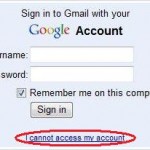Occasionally when logging into Gmail web mail interface, the following error message in bold red color may display prominently on the top of the mailbox:
Your browser’s cache is full and may interfere with your Gmail experience.
Gmail gives a link for user to “Fix this” (which just redirect to a Gmail Help Center topic), and also a “Hide” option which temporarily make the warning message disappears (but will keep coming back on next sign in).
The Google suggested resolution asks for clearing of web browser’s cache (known as Temporary Internet Files in Internet Explorer), and in some cases, it may be necessary to clear the browser’s cache more than once and/or restart the computer to completely fix the problem.
However, in Internet Explorer 6 (IE6) and Internet Explorer 7 (IE7), some user seems to encounter the cache full issue repetitively without reprieve even though they have tried to clear and delete off the cache more than one times. The red warning message about full browser’s cache and may interfere with Gmail experience keep coming back on reloading of Gmail webmail interface.
Gmail makes use of web browser cache for prefetching mail contents and attachments, especially on AJAX-intensive standard view of Gmail. There are many solutions or workarounds that reportedly work to fix the problem for some users, while may not solve the issue for some. So try out the following possible fixes to do away with “Your browser’s cache is full and may interfere with your Gmail experience” error message and ensure that Gmail is always in tip-top condition when using it.
Resolution 1: Check for newer versions of stored pages automatically
Try to change the option for “check for newer versions of stored pages” to Automatically, instead of “Every time I visit the webpage” or “Every time I start the Internet Explorer”.
Resolution 2: Reset and Restore the Temporary Internet Files (Cache for IE)
Create a temporary folder anywhere you prefer (e.g. C:\TempCache).
In IE, go to Tools menu, then click on Internet Options. On the General tab, click Settings under Temporary Internet Files (IE 6) or Browsing History (IE 7). Click on Move Folder under current Temporary Internet Files folder, and then select the temporary folder created earlier (e.g. C:\TempCache), and finish with OK. Log off and log on to Windows again if prompted, or exit from all dialog boxes.
In either My Computer or Windows Explorer, delete the existing Temporary Internet Files folder (normally at %systemdrive%:\Documents and Settings\user\Local Settings\Temporary Internet Files folder for Windows XP or C:\Users\user\AppData\Local\Microsoft\Windows\Temporary Internet Files folder in Windows Vista and Windows 7), and then create a new folder in the same location with the same name.
Repeat the Move Folder step again and select the newly created which is also the original but has been emptied Temporary Internet Files which replaces the old IE cache folder.
Resolution 3: Using HTTPS Secure Connection to Access Gmail
The cache full error message mostly happens on non-secure (HTTP) connection to access Gmail, which use the address http://mail.google.com/. It appears that the issue doesn’t arise when using secure connection to access Gmail via https://mail.google.com/. Other than solving the problem, HTTPS URL provides encryption, which ensure the security of your email messages, and is the recommended way to login and using Gmail too.






